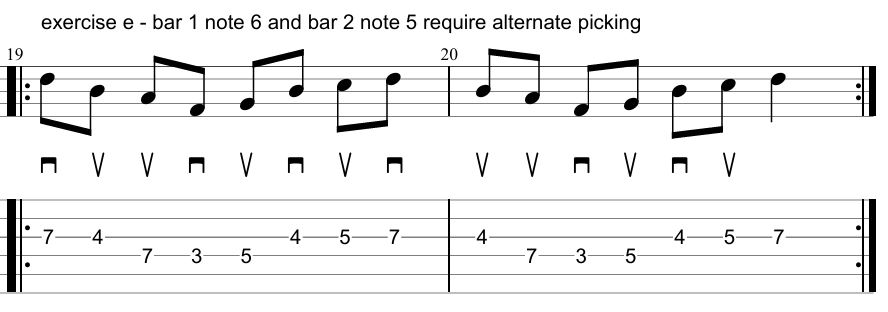Directional Picking: The Ultimate Goal in Picking Single Notes
/by Dennis WingeGuitar playing is an ever-evolving journey, with countless techniques to explore and master. Among these, directional picking stands out as the ultimate goal for players seeking efficiency, speed, and adaptability. It’s the culmination of foundational techniques like alternate picking and economy picking, blending their strengths while minimizing their limitations. In this article, we’ll explore what directional picking is, why it’s the ultimate goal, and how it can transform your playing.
What Is Directional Picking?
Directional picking is a hybrid technique that combines the strict down-up-down-up motion of alternate picking with the efficiency of economy picking. The central idea is to always take the shortest, most natural path for the pick to reach the next note. This approach eliminates unnecessary hand movement, making it the most efficient picking technique.
Here’s how it works:
- Same-String Notes: On a single string, you use alternate picking (down-up-down-up).
- String Transitions: When moving to a new string, instead of maintaining strict alternation, the pick follows the shortest path. For example:
- If the last note on the first string is a downstroke, and the next note is on a higher string, the pick continues with a downstroke (sweeping motion).
- If the last note is an upstroke, the pick transitions with an upstroke.
This flexibility allows for seamless transitions between strings, reducing unnecessary effort and enabling greater speed and fluidity.
Why Directional Picking Is the Ultimate Goal
Directional picking represents the pinnacle of efficiency and adaptability in guitar technique. Here’s why:
1. Maximum Speed with Minimum Effort
By always following the shortest path, directional picking reduces wasted motion. This efficiency translates directly into speed. Where alternate picking may require extra effort to reverse the pick’s direction unnecessarily, directional picking minimizes strain, allowing for faster, more fluid playing.
2. Adaptability Across Musical Styles
Unlike economy picking, which often relies on three-notes-per-string patterns, directional picking adapts to any musical passage. Whether you’re playing odd-note groupings, syncopated rhythms, or complex runs, directional picking allows for a natural flow without being tied to specific patterns.
3. Combining Precision with Fluidity
Directional picking merges the precision of alternate picking with the smoothness of economy picking. This makes it ideal for passages that require both clarity and a legato feel, such as jazz improvisations or fast shred lines.
4. Freedom in Musical Expression
While economy picking can feel restrictive due to its reliance on specific patterns, directional picking offers complete freedom. You’re not bound by pre-planned fingerings or note groupings, giving you the flexibility to play any line or phrase with ease.
Building Blocks
Before diving into directional picking, it’s essential to master its building blocks:
Alternate Picking
Alternate picking trains your hand to maintain rhythmic precision and consistency. By practicing strict down-up-down-up patterns, you develop the timing and muscle memory needed for fast, accurate picking.
Economy Picking
Economy picking introduces the concept of minimizing movement by sweeping when transitioning between strings. This technique builds on alternate picking by teaching you to think about efficiency, which is a cornerstone of directional picking.
How Directional Picking Works in Detail
To fully understand directional picking, let’s break it down step by step:
1. Single String: Alternate Picking
When playing multiple notes on the same string, directional picking defaults to alternate picking. For example:
- Down-up-down-up for a four-note sequence on one string.
2. String Transitions: Shortest Path
When moving to a new string, the pick direction is preserved. For example:
- If you end with a downstroke on the first string, the first note on the next string will also be played with a downstroke.
- If you end with an upstroke, the first note on the next string will follow with an upstroke.
3. Combining Patterns
Directional picking seamlessly combines alternate picking and sweeping motions. Whether you’re playing two, three, or four notes per string, the pick always moves in the most efficient direction.
4. Flexibility in Note Groupings
Unlike economy picking, which often requires three-notes-per-string patterns, directional picking works with any number of notes per string. This adaptability is one of its greatest strengths.
Examples of Directional Picking
The following examples shows how a single note on a string followed by a reverse of direction creates demand for directional picking.

The Challenges of Learning Directional Picking
While directional picking is incredibly effective, it does come with its own set of challenges:
1. Breaking Old Habits
If you’ve been strictly practicing alternate picking or economy picking, it can be difficult to adapt to the fluidity of directional picking. You’ll need to retrain your hand to prioritize efficiency over rigid patterns.
2. Developing Consistency
Directional picking requires precise coordination between your picking and fretting hands. Sloppy execution can result in missed notes or inconsistent timing.
3. Mental Adjustment
One of the biggest hurdles is the mental shift required to think in terms of efficiency rather than strict alternation. This takes time and practice but is ultimately worth the effort.
Advantages of Directional Picking
Once mastered, directional picking offers numerous benefits:
1. Unparalleled Efficiency
Directional picking is the most efficient way to play. By minimizing motion, it conserves energy and allows for longer playing sessions without fatigue.
2. Enhanced Fluidity
The seamless transitions between strings give directional picking a natural, legato feel that’s ideal for fast, melodic lines.
3. Versatility
Whether you’re playing simple melodies, complex solos, or intricate arpeggios, directional picking adapts to the demands of the music.
4. Freedom from Patterns
Unlike economy picking, directional picking doesn’t require specific note groupings. This makes it a more versatile technique for improvisation and creative expression.
Practicing Directional Picking
To master directional picking, follow these steps:
1. Start Slow
Begin with simple exercises that combine alternate picking and sweeping motions. For example:
- Play a three-note-per-string scale ascending and descending, focusing on maintaining the shortest pick path.
2. Use a Metronome
Practicing with a metronome helps develop consistency and timing. Start at a slow tempo and gradually increase your speed.
3. Focus on Efficiency
Pay attention to your pick’s motion. Ensure it follows the shortest path between notes without unnecessary movement.
4. Incorporate Musical Context
Practice directional picking in the context of songs or solos. This helps reinforce the technique in real-world scenarios.
5. Analyze Your Playing
Record yourself and listen for inconsistencies in timing or tone. Use this feedback to refine your technique.
Conclusion
Directional picking is more than just a technique—it’s a philosophy of efficiency and adaptability. By combining the strengths of alternate picking and economy picking, it offers the best of both worlds while eliminating their limitations.
As the ultimate goal in picking techniques, directional picking unlocks new levels of speed, fluidity, and freedom in your playing. While it requires dedication and practice to master, the rewards are well worth the effort. Whether you’re shredding solos, improvising over jazz changes, or exploring intricate melodies, directional picking will elevate your playing to new heights.
Take the time to build a strong foundation with alternate and economy picking, and when you’re ready, embrace directional picking as the key to unlocking your full potential as a guitarist.
Book a free trial lesson, available both in-person and online. Fill out this form and we’ll respond within 24 hours.



